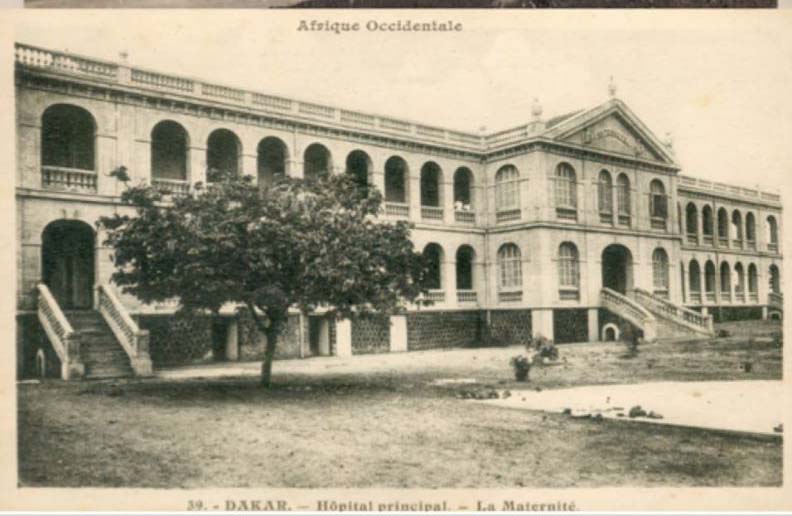Located on the Dakar peninsula, on the edge of Bernard Cove, the Hospital was inaugurated in August 1884. It included seven multi-storey buildings with brick arches facing each other, three to three, and was completed in 1897 by two two-storey housing buildings. An arcaded gallery unites these two constructions with a facade facing the Governor’s Palace.
–
The colonial hospital in 1908
–
This first set of buildings constituting the central nucleus of the hospital remains today and gives it all its charm. From 1898, the Military Hospital expands. It is completed with annexes: kitchens, laundry, chapel, mortuary.
With the yellow fever epidemic of 1900, new buildings were built to strengthen the Lazaret de la Quarantaine du Cap Manuel and shelter the contagious. Housing was also built for Senegalese infantrymen and nurses between the hospital and rue Paul Doumer (where there is a now century-old baobab tree) above the corniche. They still exist in the state under the name of “Camp of the Married”.
Expansions between 1922 and 1930
The second great architectural period is between 1922 and 1930 with the construction of four buildings in the pure colonial style:
- the magnificent two-storey building of the Maternity in 1922,
- the AOF Troop Supply Pharmacy raised by one floor of housing in 1923,
- the closure of the interior park with a two-storey cloister gallery connecting the central buildings and the seven side buildings in 1927,
- the Pavillon des Dames (now Service Boufflers) in 1930.
 –
–
The main hospital at the beginning of the 20th century. The building in the foreground will be replaced by the administrative building
Source : Métis Senegal
–
During the last period of French West Africa (AOF), new infrastructures were built, abandoning the colonial style and taking the turn of modernity.
In 1940, Doctor-Colonel Huart had an underground operating theater fitted out which received the wounded from the “Anglo-Gaulllist” operation on Dakar and was abandoned after the fighting.
In 1941, Governor General Brévié had a childcare center built which would bear the name of his wife Marie-Louis and which was the central part of the current Brévi clinic.
In 1957, the Pediatrics, which had 67 beds at the time, was built on two floors with a modern and European design, breaking with the charm of previous buildings.
 –
–
The colonial hospital in 1908
–
The changing status of the hospital
The Military Ambulance “of 1880 becomes” Military Hospital ” from 1890. The creation of the AOF in 1895 and the elevation of Dakar to the rank of capital of the AOF will give it a privileged status that it will keep when Dakar becomes the capital of Senegal.
The “Regulation of 1912” which defines the functioning of the hospitals of Overseas, will attach the establishment become “Colonial Hospital” to the Governor General of the AOF and assign to him as mission the treatment of the sick and wounded of any category with the exception of those who fall free medical assistance paid for by the Hôpital Central Indigène (current Aristide Le Dantec hospital). He receives patients from all over Senegal, Mauritania, Sudan and the doctors belong to the colonial health body.
The name “Main Hospital”, corresponding to its hierarchical level in the health organization, comes from this regulation.
 –
–
Main hospital – The maternity ward built in 1922
–
In April 1958, by an agreement between the President of the Grand Council of the AOF. and the High Commissioner of the Republic, the Main Hospital is transferred to the budget of France Overseas, but it retains its status as a French military hospital until 1971, eleven years after Senegal’s independence.
In 1971, an agreement signed between France and Senegal places the Main Hospital under the dual supervision of the Senegalese Armed Forces and the French Republic. The land, buildings and equipment are transferred to Senegal and France is responsible for their management, under the supervision of the Ministry of Cooperation. An establishment agreement drawn up in agreement with the union representations and which sets out the operating procedures is still in force in 2004.
As part of the national health policy, the Main Hospital is entrusted with the function of Instruction Hospital of the Senegalese Armed Forces Health Service for the training of the first military doctors for whom it ensures the preparation at the different levels of specialization, but also the continuous training of paramedical personnel.
December 24, 1999, a new cooperation agreement signed between Senegal and France definitively transfers all responsibilities, and in particular financial ones, to the Senegalese authorities. This new agreement specifies the new cooperation modalities concerning the Main Hospital. It marks the start of a new era for the hospital.
With law 2000-01 of January 10, 2000, carrying hospital reform, the Main Hospital of Dakar becomes, like all the other hospitals in the country, a public health establishment, but with a special status. It remains under the supervision of the Ministry of the Armed Forces.
In 2004, three years after the change of status, and in accordance with the objectives of the 1999 agreement, the Main Hospital acquires its autonomy with its advantages, but also its constraints. Most of the posts of head of service and head of department are now held by Senegalese officers. Paramedical staff and common services are mainly civilians and Senegalese. A collaboration between the Senegalese and French executives (19 cooperants) allows a scientific emulation of good quality.
–


